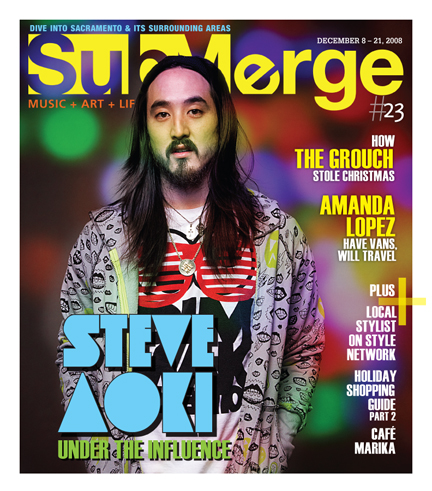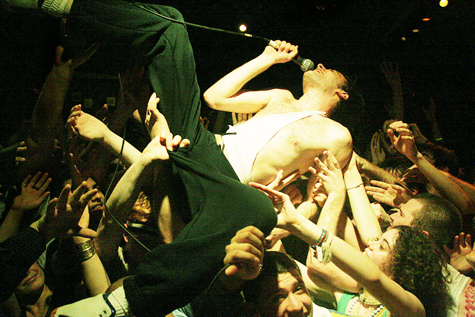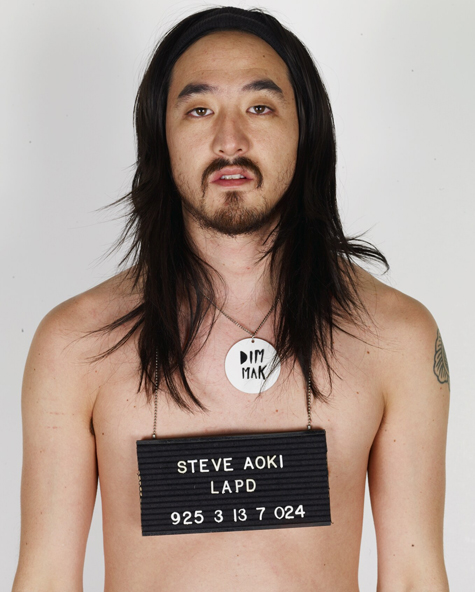DJ Shaun Slaughter Talks his Trade as Lipstick Turns 10
Words by Adam Saake – Photo by Matthew Burks
A jazz album plays in the background of Shaun Slaughter’s Midtown apartment as I sit down to discuss the 10-year anniversary of Lipstick, his indie dance club at Old Ironsides here in Sacramento. I guess maybe I expected a Phoenix song to be playing, or something along those lines, but then it all makes sense.
“I don’t want to have to play ‘1901’ ever again,” says Slaughter, half-joking. “I love that song, but I love it so much that I don’t want to play it so I don’t ruin it for myself.”
It’s like making burritos all day: you don’t hate burritos you just don’t want to have one right when you get off work. Alright, bad comparison. Indie rock isn’t really like burritos. But imagine for a second that Slaughter and Lipstick-partner-in-crime, Roger Carpio, are the tortillas. Wrapped up inside of these two musical encyclopedias is a plethora of songs that each have dug up from the depths of record bins and music blogs to play for a finicky crowd, week after week, year after year. Maybe you can’t eat Mexican food every day, but many faithful Lipstick-goers show up damn-near every Tuesday to see what the boys have drummed up now.
It wasn’t always as packed as it is these days; it was a bit of slow climb. And in the beginning it wasn’t always just Slaughter and Carpio. The original Lipstick lineup consisted of four DJs who all had very different ideas about how the night should sound. But what unified them was one simple idea–make them dance.
Slaughter was friends with a fellow house-head named Chad Nardine. Both he and Slaughter were new to downtown. Slaughter himself was a kid from the suburbs and barely 21, and they were given a slot at the Press Club to DJ. They cut their teeth there for a while but frustrations with the manager and too many randoms walking in requesting Madonna had them looking elsewhere. They were then approached separately and asked to DJ at Old Ironsides on one fateful Tuesday. Realizing they had both been solicited for the same gig, they of course decided to do the night together.
“Our first Tuesday ever was just Chad and I, and it was all electronica and it bombed,” says Slaughter. “No one was there!”
The two needed to revamp, so they went back to the drawing board to figure out how they were going to put together a better club night that would hit. The two of them were growing tired of DJing dance music and Slaughter had a taste for older alternative rock like the Rentals, Weezer and Sonic Youth. Nardine picked up on this and told Slaughter about Carpio.
“Chad said, ‘I have this friend named Roger who’s really into Britpop,” recalls Slaughter. “And I had no idea what that even meant.”
Carpio added his own ideas to the sound of the night and each peppered in their unique styles. To round out their indie rock dance night, Roger brought one more DJ into the mix.
“Then Roger said, ‘I know this guy Sean Meyers who DJs really good ‘60s rock.’ We heard him play this set one night, and it was just amazing. We added him on and then it was the four of us,” says Slaughter.
During that first year of Lipstick at the Press Club, the four played to lackluster response and were perfectly OK with that. The few that showed up showed support the best way a DJ could hope for.
“It was good, and we were happy with 30 or 40 people,” says Slaughter. “We couldn’t believe that people would dance to it.”
Nardine eventually ended up moving away and Meyers excused himself to pursue other endeavors. That left the two DJs, Slaughter and Carpio, who couldn’t have been more different from each other. But what at first may have seemed like a duo doomed to butt heads, disagree over music choice or altogether fail as partners ended up being the exact right pairing that would keep Lipstick running after all these years.
“We were both really particular about how the night went,” explains Slaughter. That’s why…it’s been around so long. Both of us were really stuck on the fact that it had to be a certain way.”
And that certain way was “some indie, Britpop and some old stuff” as well as no guest DJs. Whatever they were playing, they were doing something right and that mindset of sticking to a format was the foundation that drew in crowds night after night. Over time, though, the box they DJed inside of eventually proved to be too small and it was time for more legroom.
“I think that if we would have stuck with that, it would have just died out, because ultimately people don’t want to listen to the same stuff,” says Slaughter.
So again, what the two shared in common was what kept Lipstick new and interesting over the years. Their shared passion for discovering new music coupled with Lipstick happening every week made for the right motivation to keep introducing the dance floor to new bands.
“Roger and I are super avid. All we do is dig for music and listen to new stuff,” says Slaughter.
At times it can be “a double-edged sword” Slaughter says, hand on his chin and thoughts on his mind. Keeping the night always new and always changing is fun when you’re a DJ because you’re never playing anything out. You’re able to keep a song like “1901” for your own enjoyment. Yet, certain songs are guaranteed to pack the dance floor and in the end, isn’t that your job as a DJ?
“You’re doing people a disservice if you don’t play some of that stuff,” says Slaughter. “You do it every Tuesday and you’re thinking, ‘Fuck! I’ve heard this song so many times.’ But then I think about the people who haven’t been coming every week and how excited they are to dance to a song they’ve never heard before.”
It’s rare for anything in the music and art scenes to last 10 years, let alone a club night. People change, bars close, relationships go south. It’s just the way it is. For Lipstick to have endured 10 years on an ever-changing music scene and all the while under what seems like constant scrutiny from naysayers calling Lipstick a club night for “hipsters,” is pretty amazing. This common misconception is immediately squashed when you walk through the doors on any given Tuesday. It’s a shot in the dark as to whom you’re actually going to find inside at the bar. Most likely you’ll find those same naysayers who are socializing with the “hipsters” while buying shots for your introverted co-worker from the office.
“We’ve gone through so many waves,” explains Slaughter. “Roger is like, ‘Dude. How many times have we gone through this?’”
Maybe that’s why Slaughter and Carpio have stuck it out all these years. Keeping the crowd showing up is one thing, but keeping themselves interested is another. But when each year brings a new crowd, with new friends and more good times to add to the memories, it makes it easier to stick around. Plus, Slaughter and Carpio switch it up around town and have been behind the wheel of many other successful, and most importantly, just really fun club nights around Sacramento. One of their most popular nights, FUCK Fridays at the Townhouse Lounge, is their sort of alter egos where they can completely let loose. Here they promote a “let’s lose our shit and go completely crazy” attitude while Slaughter is dressed up as say, an M&M or a rat costume [pictured].
What people don’t always realize is that many DJs and promoters in Sacramento, including Slaughter and Carpio, have their finger on the pulse of what’s good in the music and club scenes around the country. Slaughter frequently travels to other cities to DJ, and when he returns he brings back with him the best ideas he’s encountered to apply to his own club nights. In the words of Slaughter, “We stole everything from somebody.” Although, I prefer borrowed, for what are ideas without inspiration?
“Everyone always thinks there is something better,” says Slaughter. “Compared to a lot of other cities, we’re actually doing pretty well. The nights we’re throwing are really current.”
Recently, Slaughter has been focusing his energy on the production side with a new project called D.A.M.B. that just got picked up by DJs Are Not Rock Stars Records. “Daylight,” his first track released, plays with samples of Harry Belafonte’s “Day-O” backed by a tropical house beat. His second track, “Waiting,” has already been remixed by the LOL Boys, Mom & Dad and Wolfie and has found its way around a number of high-traffic blogs. Not too bad for his first two tracks. We’ll see where it goes in the coming months, seeing as how Slaughter has his hands pretty full booking up-and-comers for FUCK, scouring the Internet for Lipstick and doing the graphic design for all his flyers. It’s a lot of work, but he’s managing to make a living doing what he loves.
“I’m definitely super, super happy. I could be playing Top 40 every night,” says Slaughter. “I get the privilege of DJing with Roger too, and I get to hang out and get paid to do something amazing. I think it’s insane that after 10 years people are still there.”
Here’s to another 10.
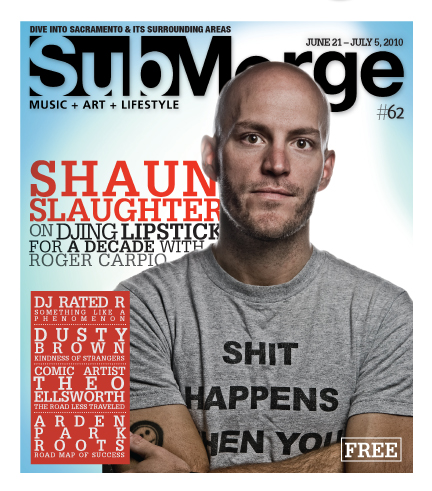
Check out Lipstick Tuesday nights at Old Ironsides. For more info, go to www.blasefaire.com.
Gregg Gillis Discusses the Finer Points of Girl Talk
Other than at the Grammys, it might be hard to imagine Busta Rhymes and Sting in the same room, let alone collaborating with one another. However, in the capable hands of Gregg Gillis, the two might as well be Simon and Garfunkel.
Much like a circus clown twisting hotdog-shaped balloons into safari animals, Gillis pieces together bits of pop music into his own compositions under the guise Girl Talk. He started “the project,” as he calls it, in 2000; but it wasn’t until his 2006 release, Night Ripper, that Girl Talk caught fire outside Gillis’s hometown of Pittsburgh, Penn.
Night Ripper‘s success allowed Gillis to quit his day job as a biomedical engineer to dedicate all his time solely to his music. He says that the extra free time was invaluable when creating his most recent album, Feed the Animals, which was released on Illegal Art in June 2008.
“When I quit the job, [my music] became more of a day-to-day process, which was good, because the whole thing for me is trial and error,” Gillis explains. “Most of the time is preparing the tools, isolating loops, making beats and things like that, and when I make all these things, I don’t know that they’re going to work out. The more tools I prepare, the more potential material I have. I feel like that all went into Feed the Animals, and that’s all because I had the free time to work on things.”
Feed the Animals was released on a pay-what-you-want basis, much like Radiohead’s In Rainbows. Gillis and Illegal Art’s decision to do so was based on their understanding of Girl Talk’s fan base.
“It just seems logical,” Gillis says. “I’m fully aware that most people are able to download music for free. Especially the fan base that listens to my music—they’re most likely connected to the Internet.”
And he was pleased with the results. The album did well enough financially that Gillis says Illegal Art wants to release all its future albums in the same manner (as well as its back catalog), but more so than money, Gillis was happy with the speed with which the pay-what-you-want model got his music to his fans.
“The ultimate goal for me was to get the music out there as soon as possible,” Gillis says. “We just uploaded it on some random day last summer and within a week, reviews were coming out; within a month, it showed up in Rolling Stone, and at the next week’s show, people knew all the words to the songs and were requesting songs.”
Gillis reports that he’s been spending the summer playing weekend shows at festivals. One such event is the Wanderlust Festival, a three-day event in Lake Tahoe that combines live music and yoga.
The first time I saw you do your thing was a show in Las Vegas. You were opening up for Kanye West.
Oh yeah [laughs]. That was super weird.
That Kanye West show was Valentine’s Day 2007, so that was just a few months after things really jumped off for me. My history was that I’d play any show—whether it was five people, 100 people, 1,000 people, whatever. I was happy to bring this show to whichever audience—if they loved it, hated it, whatever; I thought it was all valuable. Around that era was when I was first getting going into larger shows, so I was down to do whatever. Not that I wouldn’t do that show now, I just kind of knew the potential for awkwardness or weirdness with that show, considering that I was going on right when doors opened and no one knew who I was. Around that time, I was getting a lot of funny offers and it was all so surreal to me, and I just wanted as many of those as possible, so around that era, I had a handful of shows that were beautiful disasters.
When you’re creating beats and isolating loops, is there something you’re looking for specifically? Is there something that captures your ear?
Not necessarily. Any isolated part has the potential to work”¦ Certain things jump out more than others. Certain things are very rhythmical and you can tell it’s going to form into a very functional loop, but other times it’s really hard to tell. Sometimes I’ll isolate a loop, and I’ll love it and think it will work out very well, but then I can’t find anything that it will work with. There are some things that will sound OK, but I’m really particular about it. Sometimes, even with the material on the last album, I sampled some of that material five or six years ago, and I just never found its place until I started fooling around. So I kind of have a hunch when I hear an instrumental or an a Capella, that sort of thing, but I don’t know for sure. A lot of the stuff I mess around with goes nowhere.

Even growing up, maybe when you were just a fan, did you always listen to music in this way?
I don’t know, maybe to a degree. I feel like anyone trying to think back to earliest memories of getting into records, there are just segments that you really like. I don’t know whether I was looking for an isolated part, but I’ve always taken to music where there might be a five second part within a whole pop song that really catches you, that’s really a cool part”¦ Some of the rap music that I listened to growing up, a lot of it was collage-based. You know, like the NWA and Public Enemy records—even a Kris Kross record—they have a lot of samples that are coming and going. There are a lot of transitions. And sometimes those transitions might be your favorite part. I think the idea of isolating little pieces, or having something small being a very important and functional part of the song, was something I was aware of.
I’d read an interview where you said that Feed the Animals was more of a pop record than your previous albums. Is pop music something you’ve been really getting into more and more?
It was always based around pop, but the goals were a lot different. I was trying to make more experimental music, but over the years, I became more comfortable with making more accessible music, and I also developed skills with the software, and I was able to make more accessible material because of that. As the process has gone on, I don’t actively pursue source material too often, but I listen to pop music all the time. I feel like just naturally, because of what I do, I’ve gotten more deeply into the history of pop. These days, I buy more older records than new records. That’s just something that naturally came about. I sampled a little ’80s, a little ’70s, a little ’60s. You’re familiar with a lot of those songs without actually remembering them”¦ I’ve sampled some obscure things and some really obvious things, but I feel that diversity on the album
is important. It’s all Top 40, but I feel there are different levels of familiarity within that spectrum.
Do you think that’s part of the fun for your listeners, picking out where the different samples have come from?
Definitely. I think there are certain songs in there that people may have heard a couple times in their lives if they don’t actively listen to the radio—or something they may have heard in a commercial or at a wedding. That’s something I take very seriously. That’s like what I was talking about earlier—having a lot more source material around me. It would be easy to make an album with every popular dance song. There’d be Earth, Wind and Fire, and “The Humpty Dance,” The Jackson Five. That’s cool, but that’s not the goal for the record. I don’t want to make it the MTV Best of Party to Go mix. A lot of those kinds of songs will come and go in the set, and I’ll pair those next to a Chicago song. I feel like that’s part of the fun—the coming and going. I don’t want it to be all recognizable things all the time. I like to play with slightly more obscure things. Sometimes those things are rewarding, like a song that you haven’t heard in a really long time or you barely know, and now it’s put in a whole new context.
You’ll be performing at the Wanderlust Festival up in Tahoe. The festival’s a bit different because it combines live music and yoga. Do you practice yoga yourself?
I don’t. My tour manager David, who since last fall has been my right hand man, he practices yoga. He’s very excited about this. I don’t have a problem with the practice of yoga; I just haven’t gotten into it. You never know, maybe at the festival, I can get into it.
Do you think performing at a yoga festival is going to affect your show at all?
Sure. I think every show is different to some degree. It’s all about the context and what’s going on in the audience. There are a lot of variables. I try to bring the same amount of energy to every show and try to push a similar vibe—this chaotic kind of party. Sometimes it goes off, and sometimes it goes off less. I’m not really opposed to anything, and I don’t have a standard in my mind of how I want this to be. I don’t want to stereotype people who do yoga as more chill than anyone else, or less fun concertgoers. I’m expecting the normal show. If it doesn’t go down, and it’s not that crazy, I love to push the crowd and get them to warm up.
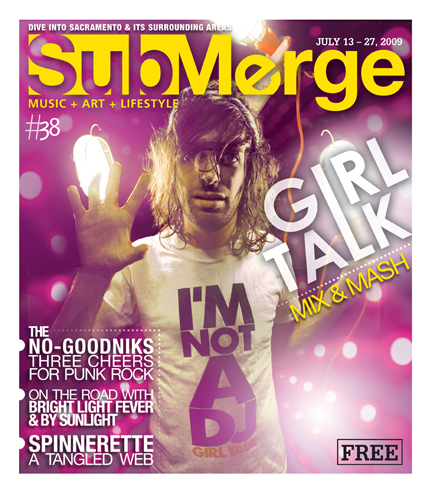
Shut Up and Dance
Clicking through pictures on The Cobrasnake, Los Angelean photographer Mark Hunter’s Web site that documents the revelry of his friends and acquaintances, it would seem that, even though much of the world is mired in an economic crunch, excess is still alive and well. At a cursory glance, it would seem that Hunter’s world is full of designer clothes, designer people and designer drugs. And if Hunter is the man who catalogs the flamboyant sights of the Los Angeles (and worldwide) party scene, then it’s DJ Steve Aoki who provides the sounds.
However, to just write Aoki off as the hipster Pied Piper would be a mistake. Born into money (his father, Hiroaki “Rocky” Aoki, recently deceased, was the founder of the Benihana chain of restaurants), Aoki didn’t let his station dissuade him from forging his own path. While pursuing a B.A. in women’s studies and sociology at UC Santa Barbara, Aoki started producing records and hosting underground shows out of his apartment, forging the foundation of what would become long-running L.A.-based music/fashion boutique label Dim Mak, which, unlike many others in the record industry, is thriving in the niche it has carved out for itself.
“You just always have to throw away the old model,” Aoki says of his 12-year-old label. “You have to move with what the new signs of the times are. There are different ways of selling records and making money, creating revenue streams with music. It’s not just record sales. Sometimes we’ll give away one of our singles, just to promote our artist, and find ways to make money around that.”
Aoki’s pursuits do not end at his label, however. He also designs clothes for KR3W Apparel and Supra Footwear; has produced remixes for Lenny Kravitz, Chester French and Robin Thick (and had just turned in one for All American Rejects at the time of this interview); released his first solo mix album, Pillowface and His Airplane Chronicles, in January of this year [2008]; and, following in his father’s footsteps, opened up a restaurant in L.A. called Shin with a few of his celebrity friends. All that, of course, is in addition to performing as a DJ, which has kept him booked solid “25 dates every month” in 2008. Submerge spoke with Aoki during a break from working the studio, a night before he was set to begin a string of DJing dates starting in Porto Alegre, Brazil.
I’d read in an interview that you were hoping to tour less in the future.
Exactly. I’ve just opened a restaurant in L.A. I bought a house here. I’m producing a lot more tracks. All my businesses are running out of L.A. I just love being in L.A. And I just love doing nothing sometimes.
You do have a lot of different ventures. When you go on the road, do you think they suffer without your attention?
You know, Dim Mak records, we’ve been doing that for 12 years. This year, I’ve been, like, gone a lot, right? I’ve been gone 25 dates every month, and the label has just grown exponentially even while I’ve been gone. I just have the right team. I feel like I have the right people around me to run all the different things for me. The clothing line is growing fast and doing really well. I have deadlines that I work with for all the different companies I design—you know, I develop lines for three or four different companies—so I have my own deadlines that I have to handle with these different companies, which is a pain in the ass because everyone has their own seasonal deadlines. The fashion side of things keeps me really fluidly working. I’m constantly working on different stuff. The production, I’ll be in the studio for 12 hours straight and pumping out remixes. I don’t do it every day; I just do it when it needs to get done. There are certain things that take up a bulk of my time, and some things that are, like, constant.
You’ve played some exotic locations; and in December, you’ll be playing The Park Lounge in Sacramento. You’ve been here before. What are your impressions of Sacramento?
I DJ’d at The Park, so it wasn’t a good representation of the nightlife culture there. I’m going back there to play, but this time, I’m not going to play any fucking hip-hop. I’m going to play my dance set and see what people think about that.
Do you feel out the crowd when it comes to what you’re going to play?
I want to be democratic. I don’t want to be a complete snob. I want people to have a good time. It’s not just about educating people about new songs, it’s about having fun, having a fun dance party, you know? You can’t force-feed people music. A good DJ knows how to present music in the right way.
Do you consider yourself a good DJ? Is that something that matters to you?
You mean technically?
Yeah, technically.
Yeah, I mean, it’s just like the A-plus student, the guy who has everything. He’s the Tony Hawk of DJing—he’s technically great, he’s got great song selection, he plays new music, he’s able to educate people, he’s able to be really democratic with the crowd, he’s able to please everyone—all that shit matters. The skills aren’t the only factor. If you asked me the question, “What’s more important: skill or taste?” I’d tell you taste. If a guy’s really skillful, but his tracks are just horrid, I don’t care to listen to his skill. Yngwie Malmsteem can play guitar solos for fucking 30 minutes, but I’m not going to dance to it. I really don’t care about hearing Steve Vai playing his guitar solo, or Eddie Van Halen playing his guitar solo.
Here’s the difference between Steve Vai and Eddie Van Halen: Eddie Van Halen is like, “Fuck it; I’m going to be in a rock band and write songs like ‘Panama’ and ‘Jump’ and fucking huge rock ballads that everyone knows, and everyone’s going to be dancing and having a good time, while I just kill it on the solos.” And then there’s Steve Vai who’s like, “Fuck that shit. I’m just going to be super prog and write solos all day long, and I’m only going to have a core base of like metal-head, techie, fucking dudes—and no girls.” I’m all about Eddie Van Halen.
